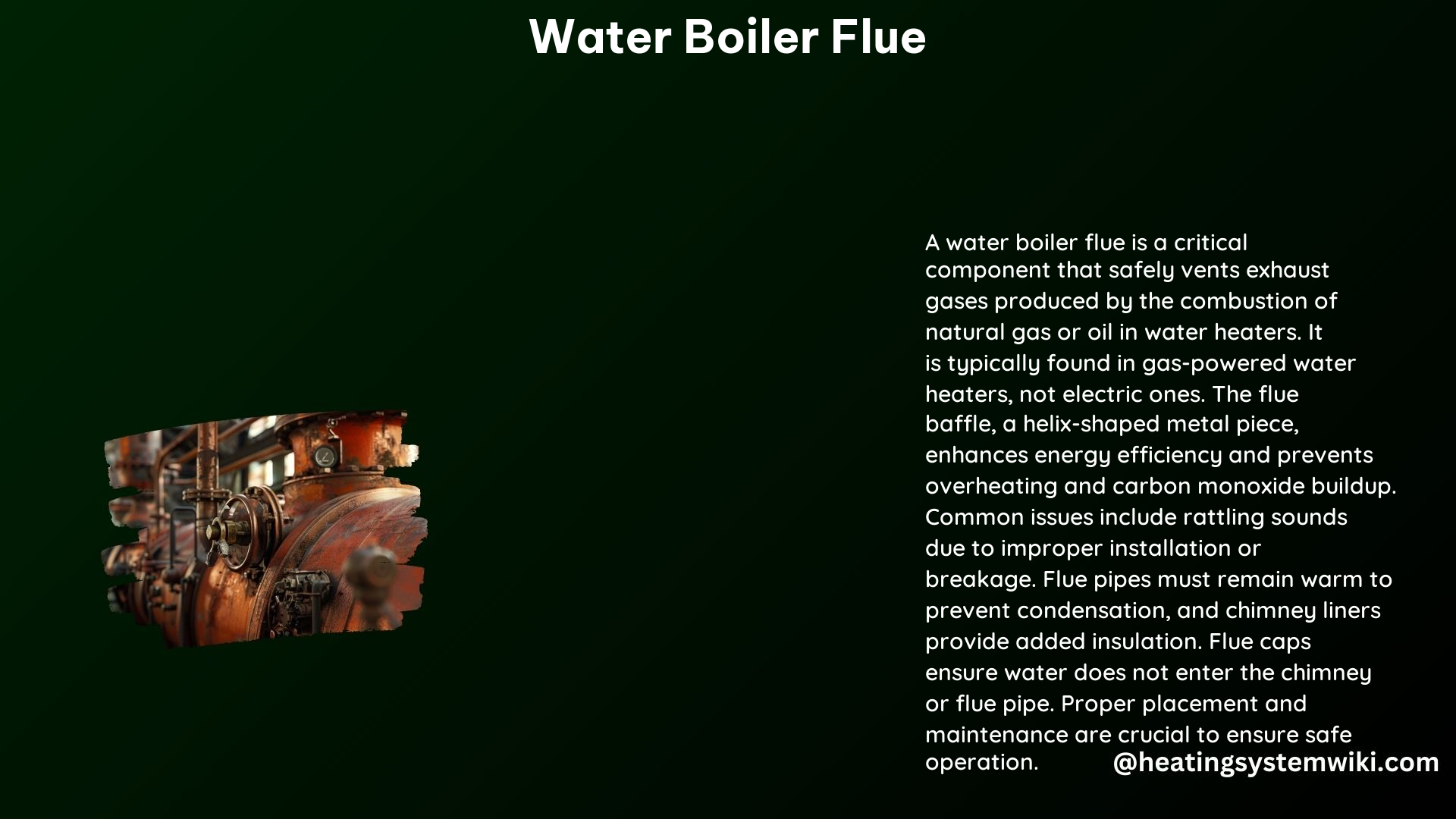The water boiler flue is a critical component of a gas-fired water heater, responsible for safely venting combustion gases and hot air outside the home. This comprehensive guide will delve into the intricacies of boiler flues, addressing common issues, recommended configurations, technical specifications, and essential DIY tips to ensure the efficient and safe operation of your home’s heating system.
What is a Boiler Flue?
A boiler flue is the boiler’s chimney, which serves to move gases and hot air from the combustion chamber to the outside. It is typically a piece of pipework or duct that ensures the safe venting of gases produced during combustion, including carbon dioxide, water vapor, and small traces of other substances like carbon monoxide and nitrous oxide.
The primary function of a boiler flue is to provide a controlled and regulated pathway for the exhaust gases to be safely expelled from the home, preventing the buildup of harmful substances and ensuring proper ventilation. Proper flue design and installation are crucial to maintaining the efficiency and safety of your gas-fired water heater.
Common Issues with Soot or Carbon Deposits

-
Carbon Monoxide Poisoning: Improperly vented flues can lead to the accumulation of carbon monoxide inside the home, which is a serious health hazard. Carbon monoxide is an odorless, colorless gas that can be fatal if inhaled in high concentrations. Proper flue installation and maintenance are essential to prevent this dangerous scenario.
-
Soot and Carbon Deposits: Inefficient combustion or blocked flues can cause soot and carbon deposits to accumulate around the exhaust flue. These deposits can restrict airflow, leading to further problems if not cleaned regularly. Soot and carbon buildup can also contribute to corrosion and premature wear of the flue components.
-
Flue Blockage: Leaves, snow, or other debris can obstruct the flue, causing gases to back up into the home. This can be prevented by installing guards or covers on the flue, ensuring a clear and unobstructed pathway for the exhaust.
Recommended Configurations for Connecting a Water Heater Flue to a Chimney
-
Horizontal Flues: Most modern boilers have horizontal flues that pass through the wall the boiler is mounted on. These flues do not typically require a cover but may need a guard if located near trees or other potential sources of debris.
-
Vertical Flues: Boilers located outside or in areas other than external walls often have vertical flues that pass through the roof. These flues require a cover on top to prevent rain and debris from entering the system.
-
Chimney Liners: Chimney liners provide added insulation to keep exhaust gases warm and prevent condensation, which can cause corrosion. They also assist with airflow and ventilation, ensuring efficient and safe operation of the boiler flue.
Technical Specifications
-
Flue Materials: Flues are typically made of metal or clay and are designed to withstand high temperatures. Common materials used for boiler flues include stainless steel, galvanized steel, and aluminum. These materials are chosen for their durability, corrosion resistance, and ability to handle the extreme temperatures generated by the combustion process.
-
Flue Size: The size of the flue is critical to ensure proper ventilation. A 6-inch flue diameter is common for many water heaters, but the specific size requirements may vary depending on the make and model of the appliance. Proper flue sizing is essential to maintain the correct air-to-fuel ratio and prevent backdrafting or other issues.
-
Flue Caps: Flue caps are used to prevent water from entering the chimney or flue pipe, protecting the system from the elements and ensuring efficient operation. These caps are typically made of metal or plastic and are designed to withstand the harsh outdoor conditions.
DIY Tips
-
Regular Cleaning: Regularly cleaning the flue is essential to prevent soot and carbon deposits from accumulating. This can be done by using a flue brush or hiring a professional chimney sweep to thoroughly clean the system. Proper cleaning intervals will depend on factors such as the frequency of use, fuel type, and local environmental conditions.
-
Proper Installation: Ensuring the flue is installed correctly and in compliance with local regulations is crucial to prevent blockages and carbon monoxide buildup. This may involve securing the flue to the wall or roof, properly sealing any joints or connections, and ensuring the flue is the correct size and material for the specific water heater model.
-
Inspection: Regularly inspecting the flue and chimney for signs of damage or blockage is essential for maintaining the safety and efficiency of the system. Look for cracks, corrosion, or any obstructions that could impede the proper venting of exhaust gases.
References
- Ideal Heating. (n.d.). What is a Boiler Flue and How Do They Work? Retrieved from https://idealheating.com/tips-and-advice/what-is-a-boiler-flue-and-how-do-they-work
- Alpine Intel. (n.d.). Why Some HVAC Systems and Water Heaters Use Flue Pipes and Chimney Liners. Retrieved from https://alpineintel.com/resource/why-some-hvac-systems-and-water-heaters-use-flue-pipes-and-chimney-liners/
- Horizon Services. (2022, December 9). What Is a Water Heater Flue Baffle? Retrieved from https://www.horizonservices.com/about-us/blog/what-is-a-water-heater-flue-baffle/
